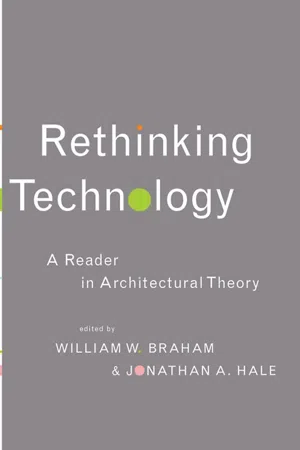
Rethinking Technology
A Reader in Architectural Theory
- 488 pages
- English
- ePUB (mobile friendly)
- Available on iOS & Android
About This Book
This essential reference for all students of architecture, design and the built environment provides a convenient single source for all the key texts in the recent literature on architecture and technology.
The book contains over fifty carefully selected essays, manifestoes, reflections and theories by architects and architectural writers from 1900 to 2004. This mapping out of a century of architectural technology reveals the discipline's long and close attention to the experience and effects of new technologies, and provides a broad picture of the shift from the 'age of tools' to the 'age of systems'.
Chronological arrangement and cross-referencing of the articles enable both a thematic and historically contextual understanding of the topic and highlight important thematic connections across time.
With the ever increasing pace of technological change, this Reader presents a clear understanding of the context in which it has and does affect architecture.
Frequently asked questions
Information
INDEX
Table of contents
- Front Cover
- Title
- Rethinking Technology
- Copyright
- Contents
- Preface
- Acknowlegments
- Introduction
- 1901: Frank Lloyd Wright The Art and Craft of the Machine
- 1914: Antonio Sant’ Elia Manifesto of Futurist Architecture
- 1915: Patrick Geddes Paleotechnic and Neotechnic
- 1923: Le Corbusier Engineer’s Aesthetic and Architecture
- 1928: Siegfried Giedion Construction.Industry.Architecture
- 1929: Le CorbusierArchitecture: The Expression of the Materials and Methods of our Timese
- 1929: Richard Buckminster Fuller 4D Time Lock
- 1929: Knud Lönberg-Holm Architecture in the Industrial Age
- 1932: Hugo Häring The House as an Organic Structure
- 1934: Lewis Mumford Technical Syncretism and Toward an Organic Ideology
- 1937: Karel Honzík Biotechnics: Functional Design and the Vegetable World
- 1939: Frederick J.Kiesler On Correalism and Biotechnique: A Definition and Test of a New Approach to Building Design
- 1941: Siegfried Giedion Industrialization as a Fundamental Event
- 1948: Siegfried Giedion The Assembly Line and Scientific Management
- 1950: Ludwig Mies van der Rohe Technology and Architecture
- 1954/1962: Team 10 The Doorn Manifesto
- 1954: Richard Neutra Survival Through Design
- 1957: Konrad Wachsmann Seven Theses
- 1959: Peter Collins The Biological Analogy
- 1960 Peter Reyner Banham Functionalism and Technology
- 1960: William Katavolos Organics
- 1964: Christopher Alexander The Selfconscious Process
- 1964: Marshall McLuhan Housing: New Look and New Outlook
- 1965: Peter Reyner Banham A Home is not a House
- 1969: Richard Buckminster Fuller Comprehensive Propensities
- 1969 James R.Boyce What is the Systems Approach?
- 1970: Peter Cook Experiment is an Inevitable
- 1972: Superstudio Microevent/Microenvironment
- 1973: Leopold Kohr Velocity Population
- 1973: Paolo Soleri Function Follows Form(Structure Before Performance)
- 1976: Ruth Schwartz Cowan The “Industrial Revolution” in the Home: Household Technology and Social Change in the Twentieth Century
- 1977: Kisho Kurokawa The Philosophy of Metabolism
- 1979: Philip Steadman What Remains of the Analogy? The History and Science of the Artificial
- 1981: Alan Colquhoun Symbolic and Literal Aspects of Technology
- 1982: Luis Fernández-Galiano Organisms and Mechanisms,Metaphors of Architecture
- 1985: Steve Ternoey The Patterns of Innovation and Change
- 1987: Martin Pawley Technology Transfer
- 1988: Bruno Latour Mixing Humans and Nonhumans Together: The Sociology of a Door-Closer
- 1988 Peter McCleary Some Characteristics of a New Concept of Technology
- 1992: Joseph Rykwert Organic and Mechanical
- 1994: Stewart Brand Shearing
- 1995: Rem Koolhaas Speculations on Structures and Services
- 1995: Félix Guattari Machinic Heterogenesis
- 1997: Francis Duffy Time in Office Design
- 1997: Paul Virilio The Third Interval
- 1999: Ben van Berkel and Caroline Bos Techniques: Network Spin, and Diagrams
- 1999: Ken Yeang A Theory of Ecological Design
- 2000: Bernard Cache Digital Semper
- 2000: Manuel De Landa Deleuze and the Use of the Genetic Algorithm in Architecture
- 2002: David Leatherbarrow and Mohsen Mostafavi Surface Architecture
- 2002: William McDonough and Michael Braungart A Brief History of the Industrial Revolution
- 2002: William J.Mitchell E-Bodies, E-Buildings, E-Cities
- 2003: SLA Changing Speeds
- 2004: Manuel Castells Space of Flows, Space of Places: Materials for a Theory of Urbanism in the Information Age
- Bibliography
- Index